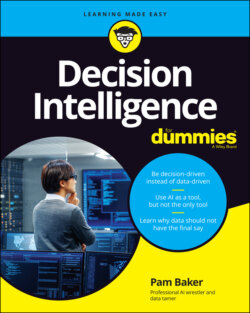Читать книгу Decision Intelligence For Dummies - Pamela Baker - Страница 38
Embracing the new, not-so-new idea
ОглавлениеThe term decision intelligence has been in use for at least the past 20 to 25 years — one of its earliest mentions is in the scholarly paper “Knowledge Management + Business Intelligence = Decision Intelligence,” by Uwe Hannig, a German academic specializing in information and performance management. The meaning of the term decision intelligence continues to change somewhat as vendors try to fit the term to their own products or purposes. Meta S. Brown, the author of Data Mining For Dummies (Wiley) and president of A4A Brown Inc., a consultancy specializing in guidance for launching and expanding analytics projects, says of decision intelligence that “solution vendors associate it with enterprise software, for example, though practitioners not tied to products see it as a broad set of disciplines brought together for decision making.”
It’s still very much a buyer-beware field, in other words. Products will be marketed as decision intelligence tools that aren’t — or perhaps are but are also good for other purposes. Just as a clawhammer can be sold as a house-building tool and a nail-puller, so, too, can many techniques, tactics and tools be used for decision intelligence as well as for other analytical tasks.
Good analytics practice in general, regardless of labeling such as AI, data science, and data mining, are found in an existing open standard for data mining process called CRISP-DM. (Check out Data Mining For Dummies if you’re curious about this standard.)
Many of the details in CRISP-DM are used by data analysts, business managers, IT leaders and others in a variety of business roles. Decision Intelligence extends on that idea.
But the distinction between the two concepts — data mining and decision intelligence — is perhaps best understood in their respective outputs:
Data science tells you what is knowable in any given universe of information. It can do so by answering your questions (data queries) or by automating pattern detection (advanced analytics or AI).
Decision intelligence, by comparison, integrates what’s known into a decision process. It’s the difference between knowing how COVID-19 spreads (data science) and using that and other information in a structured process to decide whether to allow people to return to work (decision intelligence).
Impact is ultimately the answer everyone seeks. When every business and life question essentially boils down to the question of what you should do to achieve this impact, it makes sense to start the decision-making process with the impact you seek and the answer you most need.
